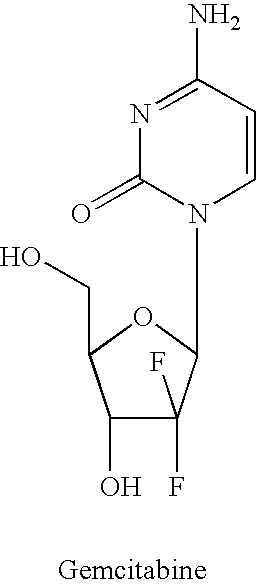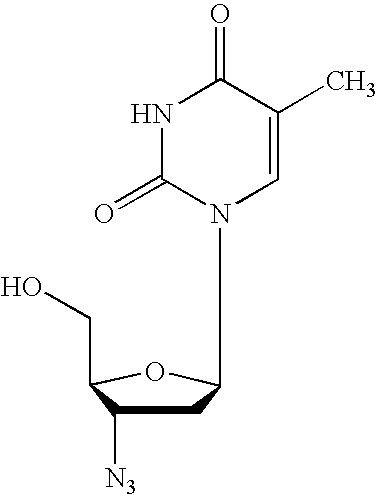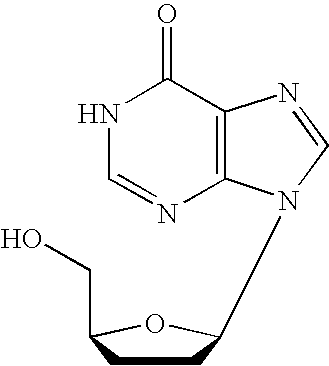Dosing regimen for gemcitabine HCV therapy
- Summary
- Abstract
- Description
- Claims
- Application Information
AI Technical Summary
Benefits of technology
Problems solved by technology
Method used
Image
Examples
example 1
[0194] Antiviral testing of candidate compounds for Flaviviridae: The HCV replicon system in Huh7 cells. Huh7 cells harboring the HCV replicon can be cultivated in DMEM media (high glucose, no pyruvate) containing 10% fetal bovine serum, IX non-essential Amino Acids, Pen-Strep-Glu (100 units / liter, 100 microgram / liter, and 2.92 mg / liter, respectively) and 500 to 1000 microgram / milliliter G418. Antiviral screening assays can be done in the same media without G418 as follows: in order to keep cells in logarithmic growth phase, seed cells in a 96-well plate at low density, for example 1000 cells per well. Add the test compound immediate after seeding the cells and incubate for a period of 3 to 7 days at 37.degree. C. in an incubator. Media is then removed, and the cells are prepared for total nucleic acid extraction (including replicon RNA and host RNA). Replicon RNA can then be amplified in a Q-RT-PCR protocol, and quantified accordingly. The observed differences in quantification of ...
example 2
Antiviral Activity of Gemcitabine (dFdC)
[0201] Gemcitabine was dissolved in DMSO and added to the culture media of a cellular model system of Huh7 cells harboring self-replicating HCV RNA, at final concentrations ranging from 0.1 to 50 dM. In such experiments, one way to express the antiviral effectiveness of a compound is to subtract the threshold reverse-transcriptase polymerase chain reactions (RT-PCR) cycle of the test compound with the average threshold RT-PCR cycle of the negative control. This value is called DeltaCt (.DELTA.Ct or dCt). With the availability of both the HCV .DELTA.Ct data and the rRNA .DELTA.Ct, a specificity parameter can be introduced. This parameter is obtained by subtracting both .DELTA.Ct values from each other. This results in Delta-DeltaCT values (.DELTA.Ct or ddCt). A 4-days incubation resulted in dose-dependant reduction of the replicon HCV RNA (FIG. 2). Since 3.3 Ct values equals 1-log reduction of replicon RNA, an EC.sub.90 value was reached at app...
example 3
Antiviral Activity of Gemcitabine After Single Treatment in Human
[0202] A male patient exhibiting multifocal HCC, cirrhosis, and ischaemic hepatitis infected with HCV was administered 1200 mg gemcitabine HCl in 1000 minutes associated with oxaliplatine. The tolerance was acceptable, and thus the next day the patient was given a second dosage of approximately 700 mg of gemcitabine. Before the second dosage the baseline viral load was 6.49 log copies / mL. The second perfusion of gemcitabine was stopped after approximately 700 mg because of heart problems. The HCV RNA measurement eight hours after the second dosage was 4.04 log copies / mL, indicating an approximate 2.5 log drop in eight hours.
PUM
| Property | Measurement | Unit |
|---|---|---|
| Time | aaaaa | aaaaa |
| Time | aaaaa | aaaaa |
| Time | aaaaa | aaaaa |
Abstract
Description
Claims
Application Information
 Login to View More
Login to View More - R&D
- Intellectual Property
- Life Sciences
- Materials
- Tech Scout
- Unparalleled Data Quality
- Higher Quality Content
- 60% Fewer Hallucinations
Browse by: Latest US Patents, China's latest patents, Technical Efficacy Thesaurus, Application Domain, Technology Topic, Popular Technical Reports.
© 2025 PatSnap. All rights reserved.Legal|Privacy policy|Modern Slavery Act Transparency Statement|Sitemap|About US| Contact US: help@patsnap.com



